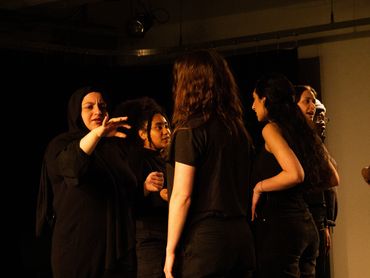Signed in as:
filler@godaddy.com
Signed in as:
filler@godaddy.com
What makes a canon? What is originality? Who claims authorship? How does a story travel through time and space? Is there such a thing as universal - perhaps love? Romeo and Juliet and Layla and Majnun examines these questions through the lens of names. The forgotten names, erased names, those who make their names, and those who get a bad name. This performance essay takes the audience on a journey through iterations of the famous Balcony Scene from Romeo and Juliet juxtaposed against Ovid’s Pyramus and Thisbe, Nizami Ganjavi’s Layla and Majnun, and my conversation with ChatGPT. Exploring aforementioned impossible questions while shifting variables of who tells which story, Romeo and Juliet and Layla and Majnun puts the following statement on trial: "For never was a story of more woe Than this of Juliet and her Romeo."






Cast
Romeo - Isaiah Dòdó-Williams
Juliet - Libby Lee
Romeo - Nancy McArthur
Juliet - Gabrielle Kogut
Ram - Jackie Leon
Julieta - Anuka Sethi
Pyramus/Thisbe - Emily Sullivan
Layla/Majnun - Ghina Fawaz
Conceived by 김채송 / Chaesong Kim & Begüm Ínal
Directed by 김채송 / Chaesong Kim
Dramaturgy by Begüm Ínal
Produced by Kalen Sakima & Ruby Wang
Costume Design by Brynne Oster-Bainnson
Lighting Design by Connor Sale
Sound Design by Anthony Sertel Dean
Projection Design by Vivienne Shaw
Photographed by Janais Axelrod
Romeo and Juliet written by William Shakespeare
Modern English translation from myShakespeare.com
Spanish translation from biblioteca.org.ar
Hindi translation by Anuka and Namita Sethi
Layla and Majun written by Nizami Ganjavi
translated by James Atkinson
abridged by Ghina Fawaz and Begüm ínal
Pyramus and Thisbe written by Ovid
translated by Rolfe Humphries
The Balcony Scene generated from ChatGPT
Nash Studios
Columbia University School of the Arts
May 2024
We use cookies to analyze website traffic and optimize your website experience. By accepting our use of cookies, your data will be aggregated with all other user data.